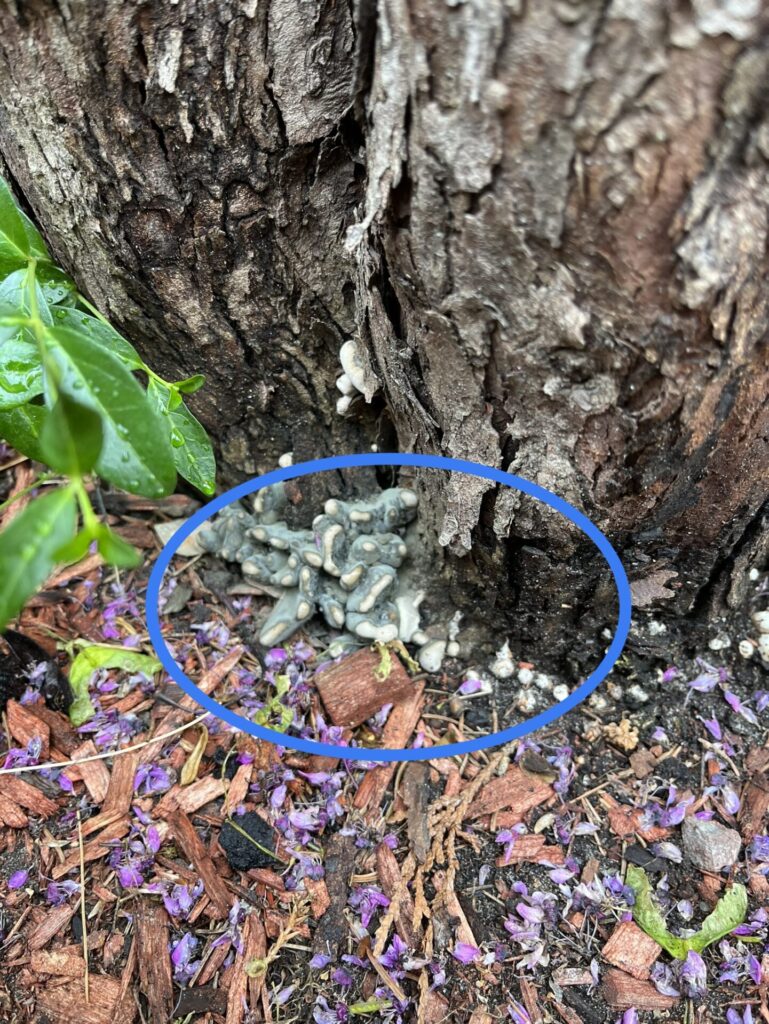
Hello, there is a grey fungus at the base of the tree. Half of the tree is now dead. Is there a way to get rid of the fungus and save the rest of the tree?
Thank-you for contacting Toronto Master Gardeners with your question.
I think you must mean Eastern REDBUD (Cercis canadensis) rather than Eastern ROSEBUD. These are such lovely trees, and native as well!
The fungus growths you are seeing at the base of the trunk of your tree are most likely symptomatic of dead tissue in the trunk. The fungus grows on dead plant material. This is not likely to be the cause of the dying back of your redbud. Redbuds are susceptible to several fungal diseases. The two that are most serious and may cause the death of the tree are: Botrysphaeria canker and Verticillium wilt.
It sounds like your tree has died back rather quickly. As noted in this Factsheet on Redbuds, the most likely problem is Botrysphaeria canker. This disease is caused by Bothryshaeria dothidia, a fungus that enters the twigs, branches or trunks of the redbud. Trees with lesions or wounds, or those suffering from drought or other stressors are most likely to succumb to the disease. The fungus feeds on the tissue of the plant and eventually girdles the branch or trunk cutting off the water supply. This causes the sudden wilting and death of the branch. There is no fungicide for this disease. The only recourse is to cut out all dead or wilted branches. Cut 6 inches below the infected area (into healthy tissue). Disinfect your pruners as you go, using rubbing alcohol. Dispose of the cut plant material in the garbage; do not compost it. Then, try to prevent the remainder of the plant from developing cankers by mulching around the trunk and watering well. Keep the tree well watered over the summer, and if it survives the winter, apply a fertilizer in spring. Keeping the tree as healthy as possible is the best guard against disease.
The other disease that could be causing your tree to suffer from die-back is Verticillium wilt, caused by either Verticillium dahliae or V. albo-atrum fungus. The first signs of this disease are yellowing and browning of leaves and inhibited growth of new leaves. This fungus lives in the soil and enters the tree through the roots. It moves through the tree via the vascular system and then grows within branches. The fungal mass eventually blocks up the vascular channels in the tree and prevents water and nutrients from reaching the branches and leaves, eventually killing the tree. In extreme cases, this can occur very quickly; in other situations it can kill the tree branch by branch, over several years. As with the canker, there is no fungicide that will cure the disease. Again, the only chance to save the tree is to cut out diseased or dead branches, ensure the tree has plenty of water, and fertilize the following spring (as described above). There is a good description of this disease and the treatment in this article on Redbud tree diseases.
Best of luck saving your Eastern Redbud. If your tree does succumb to the disease and die, note that the fungus can survive in the soil or in surrounding plant material. It is best to replace your tree with one that is not susceptible to these fungal diseases, rather than choosing another redbud.

